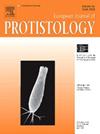Phagocytes of the forest: Are myxomycetes defensive mutualists for host plants?
IF 1.6
2区 生物学
Q4 MICROBIOLOGY
引用次数: 0
Abstract
Myxomycetes are microscopic eukaryotic organisms classified within the phylum Amoebozoa. They are naked amoebae, with or without a flagellated stage in their life cycle, capable of forming a multinucleate cell (plasmodium) and producing fruiting bodies for spore dispersal. Myxomycetes are natural bacterivores and fungivores, consistently associated with plants or plant remains in terrestrial habitats. They are commonly found on decaying wood but also occur in living plants, where they may act as mutualists. Here, we propose that these microorganisms function as primary endophytic symbionts of plants, potentially protecting them from other endophytes. We comment on published studies that support this relationship and suggest that further evidence could be obtained through molecular or genomic approaches.
森林吞噬细胞:黏菌是寄主植物的防御性互惠主义者吗?
黏菌是一种微小的真核生物,属于变形虫门。它们是赤裸的变形虫,在其生命周期中有或没有鞭毛阶段,能够形成多核细胞(疟原虫)并产生子实体以传播孢子。黏菌是天然的食菌者和食真菌者,一直与陆地栖息地的植物或植物遗骸有关。它们通常出现在腐烂的木头上,但也出现在活的植物中,它们可能是共生的。在这里,我们提出这些微生物作为植物的初级内生共生体,可能保护它们免受其他内生菌的侵害。我们对支持这种关系的已发表的研究发表评论,并建议通过分子或基因组方法获得进一步的证据。
本文章由计算机程序翻译,如有差异,请以英文原文为准。
求助全文
约1分钟内获得全文
求助全文
来源期刊

European journal of protistology
生物-微生物学
CiteScore
4.60
自引率
20.70%
发文量
55
审稿时长
14.6 weeks
期刊介绍:
Articles deal with protists, unicellular organisms encountered free-living in various habitats or as parasites or used in basic research or applications. The European Journal of Protistology covers topics such as the structure and systematics of protists, their development, ecology, molecular biology and physiology. Beside publishing original articles the journal offers a forum for announcing scientific meetings. Reviews of recently published books are included as well. With its diversity of topics, the European Journal of Protistology is an essential source of information for every active protistologist and for biologists of various fields.
 求助内容:
求助内容: 应助结果提醒方式:
应助结果提醒方式:


